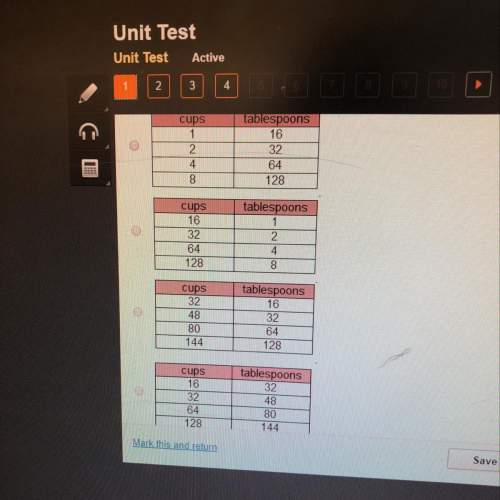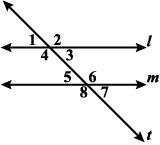
Mathematics, 27.11.2021 02:10 herchellann302
Which of the following is a slope field for the differential equation dydx=xy?
A slope field is shown with the x-axis ranging from negative 5 to 5, and the y-axis ranging from negative 5 to 5. The line segments are shown to start at a point in the second quadrant, move downward, turn toward the first quadrant and then move steeply upward. The slope is shown to increase with an increase in the value of y.
Answer A: Image with alt text: A slope field is shown with the x-axis ranging from negative 5 to 5, and the y-axis ranging from negative 5 to 5. The line segments are shown to start at a point in the second quadrant, move downward, turn toward the first quadrant and then move steeply upward. The slope is shown to increase with an increase in the value of y.
A
A slope field is shown with the x-axis ranging from negative 5 to 5, and the y-axis ranging from negative 5 to 5. The line segments are shown to start at a point in the first quadrant, move downward, turn toward the second quadrant and then move steeply upward. The slope is shown to increase with an increase in the value of y.
Answer B: Image with alt text: A slope field is shown with the x-axis ranging from negative 5 to 5, and the y-axis ranging from negative 5 to 5. The line segments are shown to start at a point in the first quadrant, move downward, turn toward the second quadrant and then move steeply upward. The slope is shown to increase with an increase in the value of y.
B
A slope field is shown with the x-axis ranging from negative 5 to 5, and the y-axis ranging from negative 5 to 5. Above the origin point, the line segments are shown to start at a point in the second quadrant, move steeply downward, become flat as it passes through any point along the positive y-axis, and then as it enters the first quadrant, move steeply upward. Below the origin point, the line segments are shown to start at a point in the third quadrant, move steeply upward, become flat as it passes through any point along the negative y-axis, and finally, it enters the fourth quadrant, to move steeply downward.
Answer C: Image with alt text: A slope field is shown with the x-axis ranging from negative 5 to 5, and the y-axis ranging from negative 5 to 5. Above the origin point, the line segments are shown to start at a point in the second quadrant, move steeply downward, become flat as it passes through any point along the positive y-axis, and then as it enters the first quadrant, move steeply upward. Below the origin point, the line segments are shown to start at a point in the third quadrant, move steeply upward, become flat as it passes through any point along the negative y-axis, and finally, it enters the fourth quadrant, to move steeply downward.
C
A slope field is shown with the x-axis ranging from negative 5 to 5, and the y-axis ranging from negative 5 to 5. Above the origin point, the line segments are shown to start at a point on the negative x-axis, moving steeply upward in the second quadrant, becoming flat as it passes through any point along the positive y-axis, and then entering the first quadrant, moving steeply downward. Below the origin point, the line segments are shown starting at a point on the negative x-axis, moving steeply downward in the third quadrant, becoming flat as it passes through any point along the negative y-axis, and finally entering the fourth quadrant, moving steeply upward.
Answer D: Image with alt text: A slope field is shown with the x-axis ranging from negative 5 to 5, and the y-axis ranging from negative 5 to 5. Above the origin point, the line segments are shown to start at a point on the negative x-axis, moving steeply upward in the second quadrant, becoming flat as it passes through any point along the positive y-axis, and then entering the first quadrant, moving steeply downward. Below the origin point, the line segments are shown starting at a point on the negative x-axis, moving steeply downward in the third quadrant, becoming flat as it passes through any point along the negative y-axis, and finally entering the fourth quadrant, moving steeply upward.
D

Answers: 1


Another question on Mathematics


Mathematics, 21.06.2019 19:00
What is the expression in factored form? -20x^2 - 12x a. 4x(5x+3) b. -4x(5x-3) c. -4(5x+3) d. -4x(5x+3)
Answers: 2

Mathematics, 21.06.2019 20:00
Afamily has five members. a mom, a dad, two sisters, & a brother. the family lines up single file. what is the probabillity that the mom is at the front of the line
Answers: 1

Mathematics, 21.06.2019 22:00
Question 10 of 211 pointuse the elimination method to solve the system of equations. choose thecorrect ordered pair.10x +2y = 643x - 4y = -36a. (4,12)b. (-3, 11)c. (2,10)d. (-5, 8)
Answers: 1
You know the right answer?
Which of the following is a slope field for the differential equation dydx=xy?
A slope field is sh...
Questions


History, 24.09.2019 11:30


History, 24.09.2019 11:30


Mathematics, 24.09.2019 11:30


Mathematics, 24.09.2019 11:30


Law, 24.09.2019 11:30



Chemistry, 24.09.2019 11:30

Biology, 24.09.2019 11:30

Mathematics, 24.09.2019 11:30

History, 24.09.2019 11:30



Mathematics, 24.09.2019 11:30

Mathematics, 24.09.2019 11:30





